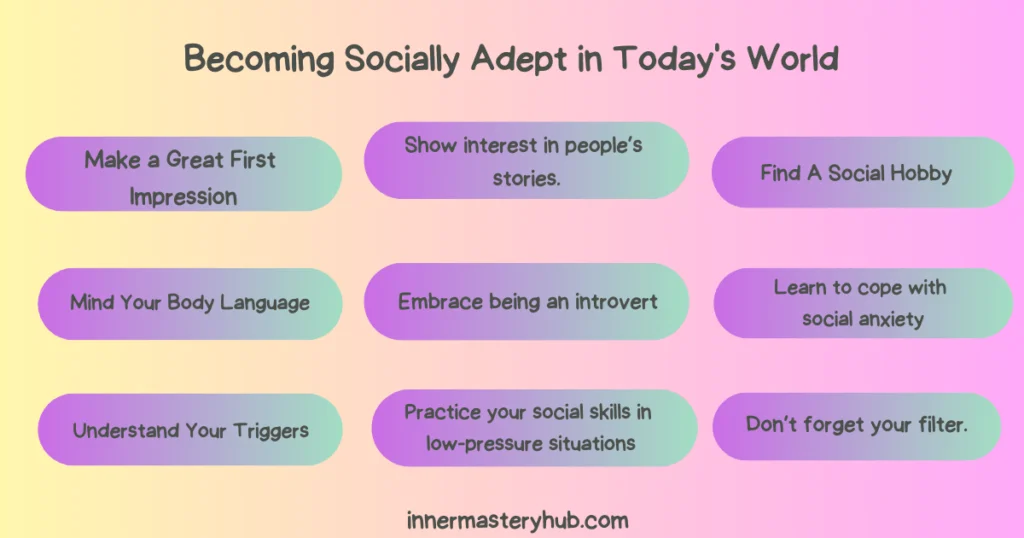
Have you ever been in a talk that went from being interesting to taking forever? Are you noting that you agree? We’ve all been stuck in a boring conversation and wished there was a magic way out. Not to worry, though, social birds! Learning how to change the subject is not as hard as you think.
You could think of it as conversation kung fu or the skill of changing the subject by asking the next person to shift from one topic to another with style and grace. This blog post will show you the tricks to avoid dullness and keep the talk strong. Get ready to say goodbye to awkward silences and hello to interesting conversations!
RELATED: Logic and the Study of Arguments: Critical Thinking Skills
Table of Contents
Switching conversation topics gently
Conversations are like journeys; sometimes, you must take a scenic detour! But how do you want to change the subject without leaving your conversational partner feeling like they just fell off a rollercoaster? Here are 7 subtle shifts that’ll keep the chat flowing smoothly:
1. Proceed with Compliments
Offering an honest compliment is like making a diplomatic transition when you want to go on to something else. You create the conditions for a seamless transition by recognizing the importance of the continuing dialogue.
For instance, Let’s imagine you are discussing a difficult project with a coworker. You realize that it’s time to switch topics because the discussion has gotten into the complicated details of the assignment.
You may say something like, “Your understanding of how to manage the complexities of this project has been quite instructive. I genuinely respect your precision and analytical style. By the way, you did a fantastic job presenting during the team meeting. How do you typically get ready for meetings this important?”
This is a twofold complement. You start by thanking your coworker for their effort, creating a positive atmosphere. Smoothly switch to another expertise, like presentation approaches. This signifies the change in topic and keeps the conversation interesting and affirming for both sides. Ensure the complement is relevant to the context to make the shift feel flawless and well-received.
RELEVANT: 22 ways to improve Cognitive skills, memory, and creativity
2. Highlight Common Ground
Let’s say you are having a political conversation with a friend. As the discussion heats up and viewpoints split, you decide to change the subject without upsetting anyone. “It’s amazing how different our perspectives can be on this political issue,” one may add. About differing opinions, have you ever considered volunteering? I had the best time lending a hand at a neighbourhood gathering.”
The appreciation of other viewpoints is the common ground here, and it leads naturally to the subject of volunteering. You create an organic-looking transition by gently drawing a connection between the two subjects.
Finding common ground is a turning point and facilitates a smooth transition from one issue to the next. By shifting the topic, you can encourage the other person to go into a different area of the conversation while still feeling connected and understanding.
RELATED: 8 Important Social Skills For Kids
3. Share a Relevant Anecdote
Anecdotes can smoothly steer a discourse. By sharing a personal or relevant tale, you add authenticity and ease the transition to a new topic with the person you’re talking to.
Example: Imagine discussing plans with coworkers. Career goals have dominated the debate, but you sense a shift. Speak smoothly, “Listening to everyone’s job objectives is inspirational.
Speaking of careers, this hilarious incident from my first job comes to mind. I learned so much then. What about you? Do you remember any early career highlights?”
The relevant tale connects future aspirations to early job experiences in this example. Using a personal tale to frame the transition makes it natural and engaging. Choose an anecdote that fits the conversation’s themes and introduces a new angle to pique people’s interest.
RELATED: Becoming Socially Adept in Today’s World
4. Ask Open-Ended Questions
Imagine talking to a friend about their workout routine. You feel like changing topics because the conversation is getting too technical about workouts. You can effortlessly transition with, “Your fitness commitment is motivating. What other leisure activities do you prefer besides workouts?”
The open-ended inquiry acknowledges fitness and expands the subject to other parts of your friend’s life. Open-ended questions inspire more expansive responses, making it easier to switch topics. Framing the inquiry to encourage others to reveal more about themselves makes the transition natural and interesting.
5. Express Curiosity
Artfully expressing curiosity can change the topic of a discussion without discomfort. Maintaining a nice, engaging atmosphere while showing genuine curiosity opens up a new topic.
Example: You’re discussing a friend’s job plan and getting technical. To ease transfer, say, “Your data analytics role fascinates me. This field is dynamic. What initially piqued your interest in this field?”
This example relies on curiosity. You show real interest in data analytics. However, asking what piqued their interest shifts the conversation to a more narrative-driven component of their work experience.
Expressing curiosity in a way that fits the conversation makes switching topics easy and fun. This strategy helps change the topic and enhances the relationship by demonstrating genuine interest in the other person’s experiences and viewpoints.
RELATED: 8 Ways to Boost Your Emotional Curiosity
6. Introduce Humor
Changing the topic using Humor is fun and effective. Adding levity may change the mood and seamlessly steer the conversation.
Example: Imagine talking to coworkers about a surprising team-building event. You may joke, “That team-building exercise took us on a wild ride!” as the subject shifts to unanticipated problems. It brought back this hilarious college incident. Any funny team experiences?”
This scenario uses comedy to address team-building in a lighthearted way. By recalling a funny moment, you establish a cheerful and relatable mood, making it simpler to switch topics. Ensure the Humor fits the situation and lightens the mood without discomfort. This strategy shifts the topic and adds fun and camaraderie to the conversation.
RELATED: The Psychology Behind Feeling Personally Attacked and How to Cope
7. Praise and Pivot
Praising and shifting are discreet methods to switch topics in a discussion. You make a good transition to the new topic by praising the old topic.
Say you’re reviewing a recent movie with a pal and getting into deep comments. Change the subject by saying, “I like your movie analysis. I liked how you handled the project last week. How do you handle tight deadlines?” talking about earlier experiences.
This example celebrates the friend’s movie observations and their contribution to the debate. After the praise, the conversation effortlessly shifts to the friend’s project management talents. This method switches the topic and creates a nice atmosphere by recognizing the other person’s contributions. Genuine praise relevant to the conversation might be used to start a fresh and intriguing topic.
Abruptly shifting the conversation’s topic to change the subject
If your casual attempts to change the subject have failed, you may need to be more drastic.
Try abruptly redirecting a conversation that makes you uncomfortable to finish it swiftly.
Here are two ways to abruptly change the topic:
1. Direct Statement
Changing the subject in a conversation with a direct statement is simple and direct. How to do it:
During a chat regarding work-related issues, it may be necessary to switch topics. You might remark, “Change gears. An fascinating travel location article caught my attention. Have you taken any exciting trips recently?”
This clear statement indicates a purposeful subject change. Travel is introduced, easing the transition. This method works effectively when you must lighten the mood or switch to a more neutral or positive topic. The idea is confidently announcing the change and introducing the new topic to spark debate.
RELATED: Pent-Up Aggression: Causes, Effects, And 16 Healthy Ways To Manage It
2. Casual Observation
Consider a chat regarding work-related stress that requires a lighter tone. You may smoothly switch topics by stating, “Isn’t the weather gorgeous today? Any weekend outdoor plans?”
This casual weather observation leads to a different topic. The nice weather adds a lighthearted tone to the talk. It allows the other person to express their plans or preferences, automatically moving the conversation away from job stress.
This method works great when you want to introduce a change without being too obvious or abrupt, keeping the conversation flowing. Choose a timely observation that will resonate with the other person.
3. Personal Announcement
Imagine you’re discussing new work tasks and want a more comfortable interaction. Say, “I tried this fantastic recipe last night. Like trying new recipes in the kitchen?”
The personal announcement about attempting a new dish changes the topic. Sharing a pleasant and personal experience lightens the topic—cooking. This method works great when you want to make a conversational change relatable and invite the other person to share their experiences or preferences. It would be best to share something that will resonate with the other person and relate the personal announcement to the new topic.
4. Current Events
Switch topics by asking, “Did you hear the news today? Interesting technology development. Your comments on recent advances?”
This example changes topics after mentioning a recent news article. By discussing technology, you shift the subject from personal to global. This method is good for adding local relevance and starting a conversation about a shared topic. Please select a current occurrence that will resonate with the other person and seamlessly link it to the new topic.
5. Setting your boundaries
Be mindful of your comfort levels, and tell the other person about your boundaries when you participate in talks. It’s acceptable to change the topic of conversation if it becomes uncomfortable for you or goes against your values. Selecting new topics should be done carefully; try to stick to topics that interest you and are comfortable for you.
Saying, “I appreciate your perspective on this, but I’d prefer not to delve too deeply into personal matters right now,” is a gentle way to establish yourself if the talk diverges into a difficult topic. Can we change things up?”
“I” sentences convey your thoughts without being hostile. Keep your boundaries without letting the other person feel attacked. If the discussion becomes argumentative, you could say, “I find this topic overwhelming. Can we switch topics?”
Establish polite boundaries when the topic is personal and you’d rather ignore it. Briefly acknowledge the discussion’s relevance, then redirect. Your anxious feelings need to change without downplaying the topic.
FAQS
Is it rude to change the subject?
Whether changing the subject is rude depends on the situation and the individuals involved. It can be acceptable if done tactfully and with consideration for the current conversation. However, abrupt changes without regard for others’ feelings or the context may be insensitive or dismissive.
Fallacy, where you change the subject
The fallacy meaning of changing the subject of conversation, also known as the “red herring” fallacy, occurs when someone introduces an irrelevant topic or argument to divert attention from the original issue. This diversion can mislead the audience and hinder the resolution of the initial discussion by introducing unrelated or misleading information.






